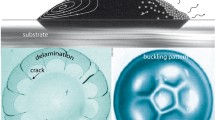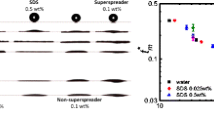Abstract
Surface ageing of a micro-drop populated by surfactants below the critical micellar concentration and subject to evaporation is considered, motivated by our interest in the transport of biomolecules in digital microfluidics. The classical approach based on diffusion–sorption processes is reviewed in order to address a finite-sized system of digital microfluidics. Short-time and long-time asymptotic approximations for a diffusion-limited regime, as well as full analytical expressions for adsorption- and evaporation-limited regimes, are constructed, which help to validate numerical calculations of full coupling between all these kinetics. The impact of the small drop size and the continuous lack of equilibrium induced by evaporation are described by introducing specific dimensionless numbers. By taking into account evaporative mass transfer in the mass balance, the boundary condition for surfactant transport to and from the interface is modified. Furthermore, the small size of the geometry suggests allowing a novel non-dimensionalisation for surface concentration, following from the mass balance of surfactant molecules in thermo-dynamic equilibrium. This order of magnitude quantifies the equilibrium surface concentration for small-sized geometries.




Similar content being viewed by others
References
Anna SL, Alvarez NJ, Walker LM (2010) Diffusion-limited adsorption to a spherical geometry: the impact of curvature and competitive time scales. Phys Rev E 82:011604
Bayley H, Maglia G, Heron AJ, Hwang WL, Holden MA, Mikhailova E, Li Q, Cheley S (2009) Droplet networks with incorporated protein diodes show collective properties. Nat Nanotechnol 4:437–440
Bexon R, Picknett RG (1977) The evaporation of sessile or pendant drops in still air. J Colloid Interface Sci 61(2):336–350
Dufour R, Harnois M, Coffinier Y, Thomy V, Boukherroub R, Senez V (2010) Engineering sticky superomniphobic surfaces on transparent and flexible PDMS substrate. Langmuir 26(22):17242–17247
Filippov LK, Filippova NL (1996) Dynamic surface tension and adsorption kinetics in finite systems. J Colloid Interface Sci 187:352–362
Garrell RL, Yoon JY (2003) Preventing biomolecular adsorption in electrowetting-based biofluidic chips. Anal Chem 75(19):5097–5102
Gutiérrez JM, Porras M, Solans C, Gonzalez C, Martínez A, Guinart A (2004) Studies of formation of W/O nano-emulsions. Colloids Surf A 249:115–118
Kim HK, Nam YS, Kim JW, Shim J, Han SH (2010) Silicone oil emulsions stabilized by semi-solid nanostructures entrapped at the interface. J Colloid Interface Sci 351:102–107
Landfester K, Musyanovich A, Mailänder V (2005) Miniemulsion droplets as single molecule nanoreactors for polymerase chain reaction. Biomacromolecules 6:1824–1828
Laradji M, Yao JH (1993) Dynamics of Ostwald ripening in the presence of surfactants. Phys Rev E 47(4):2695–2701
Lionello A, Josserand J, Jensen H, Girault H (2005) Protein adsorption in static microsystems: effect of the surface to volume ratio. Lab Chip 5:254–260
Malk R, Rival A, Fouillet Y, Davoust L (2010) EWOD in coplanar electrode configurations. ASME Conf Proc 2010(54501):239–248
McHale G, Rowan SM, Newton MI, Banerjee MK (1998) Evaporation and the wetting of a low-energy solid surface. J Phys Chem B 102:1964–1967
Picard C, Davoust L (2006) Dilational rheology of an air-water interface functionalized by biomolecules: the role of surface diffusion. Rheol Acta 45:497–504
Picard C, Davoust L (2008) Transient aging of a liquid-gas interface stretched by standing waves: On the interplay of chemical kinetics. J Colloid Interface Sci 327:412–425
Sorjamaa R, Laaksonen A (2006) The influence of surfactant properties on critical supersaturations of cloud condensation nuclei. J Aerosol Sci 37(12):1730–1736
Stebe KJ, Jin F, Balasubramaniam R (2004) Surfactant adsorption to spherical particles: The intrinsic length scale governing the shift from diffusion to kinetic-controlled mass transfer. J Adhes 80:773–796
Stone HA (1990) A simple derivation of the time-dependent convective-diffusion equation for surfactant transport along a deforming interface. Phys Fluids A 2(1):111–112
Tuteja A, Choi W, Mabry JM, McKinley GH, Cohen RE (2008) Robust omniphobic surfaces. PNAS 105(47):18200–18205
van Hunsel J, Joos P (1987) Adsorption kinetics at the oil/water interface. Colloids Surf 24:139–158
Ward AFH, Tordai L (1964) Time-dependence of boundary tensions of solutions. J Chem Phys 14(7):453–461
Wheeler AR, Luk VN, Mo GCH (2008) Pluronic additives: a solution to sticky problems in digital microfluidics. Langmuir 24:6382–6389
Author information
Authors and Affiliations
Corresponding author
Appendix: Instantaneous diffusion within a sessile drop of arbitrary contact angle
Appendix: Instantaneous diffusion within a sessile drop of arbitrary contact angle
The present model is extended to the case of a sessile drop with an arbitrary contact angle. A regime with (quasi) instantaneous diffusion is considered. The geometry of a (small enough) sessile drop corresponds to a spherical cap of radius R, with a contact angle 0 < θ ≤ π. The diffusion kinetics is considered much faster than the adsorption and evaporation kinetics (τdiff ≪ τads, τevap), such that the transport equation (2) does not need to be considered. Instead, the relation between surface and volume concentration, \(\Upgamma\) and C, respectively, may be expressed by the non-dimensional equation for mass balance:
where the form factor, \(F=2(1-\cos\theta)/(2-3\cos\theta+\cos^3\theta), \) is introduced, translating the dependences of the drop volume and drop surface on the contact angle, θ. Hence, the Henry law (1) may be reformulated to express the surfactant transport at the surface:
Furthermore, by reconsidering the mass balance for a spherical cap, the impact of the variable radius on surface concentration may be expressed:
Combining Eqs. (19) and (20) and writing,
an ordinary differential equation for the surface concentration can be derived as
with the time-dependent coefficients,
and
The evaporation law (9) also has to be modified for arbitrary contact angles:
with \(\hat F = 2/[(1-\cos\theta)(2+\cos\theta)]\) (McHale et al. 1998).
From this last expression for the time-dependent radius of the spherical cap, the differential equation (21) can be solved by making use of the integrating factor, \(\exp(\int P(t)\;\hbox{d}t).\)
Also, the surface concentration equilibrium value for microscopic systems, \(\Upgamma_{{\rm e}}^\mu,\) depends on the contact angle. It may be calculated in diffusion–adsorption equilibrium \((\hbox{d}\Upgamma/\hbox{d}t =0)\) without evaporation:
Figure 5 represents the dimensionless curves for different contact angles ranging from π/6 to π, for the non-dimensional numbers, \(\varepsilon_0=0.1\) and ηea = 1. It is remarkable that in the hydrophobic range, π/2 ≤ θ ≤ π, surface ageing is hardly affected by a change in the contact angle, whereas in the hydrophilic range, π/6 ≤ θ ≤ π/2, the impact of the contact angle becomes significant.
Impact of the contact angle, θ, upon surface ageing \((\varepsilon_0 = 0.1, \eta_{{\rm ea}} =1).\) Hydrophilic, hydrophobic and superhydrophobic contact angles are considered. The curves for θ = π/2 and θ = π yield consistently the same result as the one issued from the generalized formulation based on a spherical geometry (see Fig. 2a for comparison). Time is measured in units of τevap. The insert shows the same curves during a longer time (up to 0.5 τevap)
Rights and permissions
About this article
Cite this article
Theisen, J., Davoust, L. Surface ageing at drop scale. Microfluid Nanofluid 12, 607–614 (2012). https://doi.org/10.1007/s10404-011-0901-7
Received:
Accepted:
Published:
Issue Date:
DOI: https://doi.org/10.1007/s10404-011-0901-7





